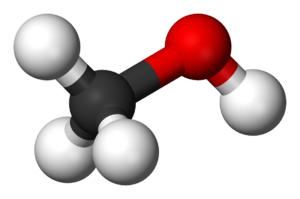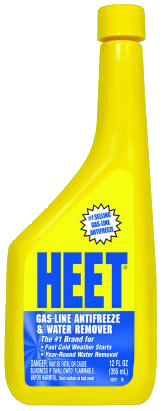Difference between revisions of "Methanol"
m (→Availability) |
m (→Preparation) |
||
| Line 147: | Line 147: | ||
==Preparation== | ==Preparation== | ||
| + | Industrially, methanol is produced by the reaction of [[carbon monoxide]] and [[hydrogen]] over a catalyst (typically a mixture of copper and zinc oxides) at high temperatures and pressures. This route is not practical on a lab scale. | ||
| + | |||
Impure methanol can be obtained via destructive distillation of wood. The process is not economically viable on a small scale, and produces many side products/contaminants, [[acetic acid]], [[acetone]], and tars among them. It is still an interesting process though, and could be attempted solely for educational value.<ref>http://www.sciencemadness.org/talk/viewthread.php?tid=2652</ref> | Impure methanol can be obtained via destructive distillation of wood. The process is not economically viable on a small scale, and produces many side products/contaminants, [[acetic acid]], [[acetone]], and tars among them. It is still an interesting process though, and could be attempted solely for educational value.<ref>http://www.sciencemadness.org/talk/viewthread.php?tid=2652</ref> | ||
Revision as of 00:13, 13 February 2019
 Methanol sample and its original bottle.
| |
 Structure of methanol
| |
| Names | |
|---|---|
| IUPAC name
Methanol
| |
| Systematic IUPAC name
Methanol | |
| Other names
Carbinol, Columbian spirits, Hydroxymethane, Methyl alcohol, Methyl hydrate, Methyl hydroxide, Methylic alcohol, Methylol, Pyroligneous spirit, Wood alcohol, Wood naphtha, Wood spirit
| |
| Identifiers | |
| Jmol-3D images | Image |
| |
| Properties | |
| CH4O CH3OH | |
| Molar mass | 32.04 g/mol |
| Appearance | Colorless volatile liquid |
| Odor | Alcoholic |
| Density | 0.810 g/cm3 (0 °C) 0.792 g/cm3 (20 °C) 0.7866 g/cm3 (25 °C) |
| Melting point | −97.6 °C (−143.7 °F; 175.6 K) |
| Boiling point | 64.7 °C (148.5 °F; 337.8 K) |
| Miscible | |
| Solubility | Reacts with acetyl chloride, formic acid, thionyl chloride Miscible with benzene, diethyl ether, ethanol, glycerol, pentane, pyridine, toluene, xylene |
| Vapor pressure | 13.02 kPa (at 20 °C) |
| Acidity (pKa) | 15.5 |
| Hazards | |
| Safety data sheet | ScienceLab |
| Flash point | 11 to 12 °C |
| Lethal dose or concentration (LD, LC): | |
| LD50 (Median dose)
|
5628 mg/kg (rat, oral) 7300 mg/kg (mouse, oral) 12880 mg/kg (rat, oral) 14200 mg/kg (rabbit, oral) |
| LC50 (Median concentration)
|
64,000 ppm (rat, 4 hr) |
| Related compounds | |
| Related compounds
|
Ethanol Propanol |
| Except where otherwise noted, data are given for materials in their standard state (at 25 °C [77 °F], 100 kPa). | |
| Infobox references | |
Methanol, or methyl alcohol is the simplest alcohol, with the formula CH3OH, also abbreviated as MeOH. It is a light, colorless, volatile, flammable liquid. It is an important chemical as a solvent and feedstock organic compound.[1]
Contents
Properties
Chemical
Methanol is a starting point for many organic compounds, such as formaldehyde, which is produced by oxidation of methanol.
- CH3OH + [O] → CH2O + H2O
Methanol burns when ignited in air to give carbon dioxide and water vapors. Minute traces of formaldehyde are produced as side product if there isn't an excess of oxygen during burning.
- 2 CH3OH + 3 O2 → 2 CO2 + 4 H2O
Reaction of methanol with a haloacid, such as hydroiodic acid will give methyl iodide.
- CH3OH + HI → CH3I + H2O
Unlike ethanol, the addition of hypochlorite anion to methanol will not give chloroform, but rather methyl hypochlorite, a very dangerous and unstable compound that decomposes violently and can even explode at high concentrations.
- CH3OH + 2 NaClO → CH3ClO + NaCl + NaOH
Methanol vapors in air will decompose over the course of several days to form carbon dioxide and water vapor.[2] Methanol is used in the production of biodiesel.
Physical
Methanol is a colorless, volatile, flammable liquid, with an alcoholic odor. It has a molecular weight of 32.04, a boiling point of 65°C and a density of 0.7914 g/cm3.[3] Methanol is miscible with a variety of organic and inorganic solvents, though not as many as ethanol. Methanol/water mixtures can be separated into two layers by salting-out with potassium carbonate.
Availability
Methanol is available cheaply from most chemical suppliers.
A type of antifreeze and automotive cleaner known as Heet can be found in most gas stations in the United States and is 99% or higher methanol. Some alternative fuels are entirely or mostly made of methanol, and due to the large quantities typically sold this can be a very efficient way to purchase it.
Methanol is sometimes sold at paint supply stores as wood alcohol, or methyl alcohol.[4] It can also be bought from scientific suppliers in higher grades. Hardware supplies sometimes sell methanol as "methyl hydrate". Finally, some home fireplaces use methanol as fuel, so it can be found in this manner as well. Some window cleaning solutions contain 50-90% methanol, along with traces of water and dye, as well traces of ethanol and or isopropanol.
In some countries the sale of "clean" (high purity) methanol may be regulated, being classified poison or due to its use in counterfeit alcohol. Since May 2018, the sale of window washers containing more than 0.6% methanol is restricted in the EU countries, though the ban seems to be largely ignored in many places.[5]
Preparation
Industrially, methanol is produced by the reaction of carbon monoxide and hydrogen over a catalyst (typically a mixture of copper and zinc oxides) at high temperatures and pressures. This route is not practical on a lab scale.
Impure methanol can be obtained via destructive distillation of wood. The process is not economically viable on a small scale, and produces many side products/contaminants, acetic acid, acetone, and tars among them. It is still an interesting process though, and could be attempted solely for educational value.[6]
Another possible preparation route involves the hydrolysis of methyl esters, like methyl benzoate.[7] This route produces much purer methanol.
Projects
- Make formaldehyde
- Make trimethyl borate
- Make methyl salicylate and other methyl esters
- Methyl iodide synthesis
- Dimethyl ether synthesis
- Direct methanol fuel cell
Handling
Safety
Methanol is significantly more toxic than other common alcohols such as ethanol or isopropanol, as it is metabolized to formic acid in the body, causing blindness and death at high doses.
Methanol flames tend to have extremely low visibility, particularly in the daytime or well-lit environments, making burning methanol difficult to detect and posing a great risk. If it is being used in instances where burning is likely, the addition of a small amount of boric acid colors the flame green and allows it to be seen.
Storage
Methanol is best kept in glass bottles away from open flames, as it is highly volatile and flammable.
Disposal
Burning methanol is a good way to destroy it. Do this outside or in a fume hood. Since methanol burns with an almost invisible flame, which can be a serious risk, it is a good idea to make the flame visible by mixing the methanol with another solvent, like ethanol or acetone. Try not to burn too much at once, to prevent its vaporization in the air or inhalation of partial oxidation products such as formaldehyde, formic acid, or carbon monoxide.
References
- ↑ http://en.wikipedia.org/wiki/Methanol
- ↑ http://pubchem.ncbi.nlm.nih.gov/summary/summary.cgi?cid=887&loc=ec_rcs#itabs-2d
- ↑ CRC Handbook of Chemistry and Physics 66th Edition, 1985
- ↑ http://en.wikipedia.org/wiki/List_of_commonly_available_chemicals#L.E2.80.93N
- ↑ https://eur-lex.europa.eu/legal-content/EN/ALL/?uri=CELEX:32018R0589
- ↑ http://www.sciencemadness.org/talk/viewthread.php?tid=2652
- ↑ https://www.youtube.com/watch?v=GJMGzIQE4RM
Relevant Sciencemadness threads
- Methanol -> methanal(formaldehyde)
- Destructive Distillation of Wood
- Methanol Synthesis(Newer thread)
- Chemical pages without CAS Registry Number
- Articles without EBI source
- Chemical pages without ChemSpiderID
- Chemical pages without DrugBank identifier
- Articles without KEGG source
- Articles without InChI source
- Articles without UNII source
- Articles containing unverified chemical infoboxes
- Chemical compounds
- Organic compounds
- Alcohols
- Primary alcohols
- Solvents
- Polar solvents
- Protic solvents
- Amphiphilic solvents
- Volatile chemicals
- Neurotoxins
- Liquids
- Essential reagents
